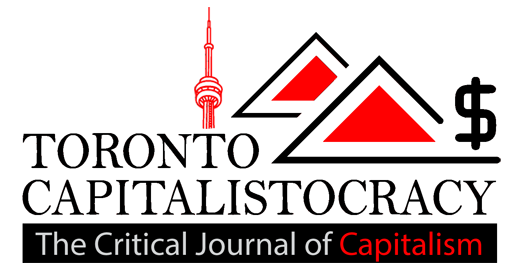Business
Republicans And Democrats Are Wedded To Capitalism. Americans Deserve Better.

When college student Trevor Hill stood up at a CNN town hall in 2017 and asked House Minority Leader Nancy Pelosi (D-Calif.) if her party might move further left to mark a starker break with right-wing economics, her answer was clear: “I thank you for your question but I have to say we’re capitalist. And that’s just the way it is.”
No major Republican has felt a similar need to affirm loyalty to capitalism; everyone quite rightly assumes it. Yet the two major U.S. political parties’ shared celebration of capitalism raises basic questions about U.S. society that deserve more attention than they get.
Capitalism’s fundamental political problem is its class division between a small number of people who are employers and the majority who are employees.
Capitalism’s cycles between good and bad times, as well as the inequality it produces through vast gaps in income and wealth, cause conflict and division. And these tensions threaten the whole system, as the recent “yellow jackets” mass movement in France demonstrates. There, a fuel tax rise sparked weeks of protest across the country as those who live beyond France’s wealthy urban centers rejected ― occasionally violently ― yet another rise in their cost of living and demanded growing concessions from French capitalism.
In response, employers have built political alliances with some parts of the employee class. For example, inside the Republican Party, they worked long-standing deals with evangelicals to, for example, oppose abortion and coalesce around Supreme Court nominees, while inside the Democratic Party, they made alliances with large groups of religious and ethnic minorities.
They have had to make these and many more such political alliances because they are simply too vulnerable to go it alone. Their alliances’ goals always included making sure that the capitalist system itself survived, partly by preventing the majority from voting for tax and regulation policies that would undo the inequalities and instabilities of capitalism.
Whichever party wins, it’s capitalism that prevails.
Despite its socially destabilizing business cycles and income inequality, U.S. capitalism has been able to reproduce itself. This was achieved through the employer alliances constructed within both major political parties.
The aim of the Republicans is to identify and appeal directly to segments of the majority that feel aggrieved or threatened by certain social trends. In the U.S., this has meant appealing to, for example, white people facing the decline of white supremacist and racist practices; men seeing their dominance lessen over women at work and at home; and religious people facing the rise of secularism or disinterest in religion.
It’s a gathering together of conservatives fearing the changes that are undermining old social positions and privileges. Its appeal is simple and clear. Vote for the GOP to have the government slow, stop or reverse those trends. The party always links that appeal to a rigid commitment to preserving and strengthening “the economy.” By this they mean private property, markets and businesses where a dominant class of employers rules over employees.
The Democrats’ mode of alliance is to appeal to the entire class of employees by endorsing state programs of mass economic, social and cultural support. For example through subsidized higher education, unemployment insurance, Social Security increases and so on. The Democrats’ plan is to pay such programs’ costs by means of taxes imposed partly on employers and partly on employees.
These state programs are pitched to employers as relatively inexpensive ways of preserving and strengthening a social solidarity that includes and so supports capitalism. The programs are pitched to employees as benefits flowing from the capitalist economy if and when they have voted to put the government in Democratic Party hands.
The Democrats have generally built alliances with those segments of the employee class who most need government support (those paid below median wage and salary levels) and with those who welcome those social trends such as secularism, urbanism, diverse sexuality and immigration that upset the people who the Republicans target for alliances. The so-called culture wars in the U.S. both reflect and reinforce the class alliances constructed inside the two parties.
Both parties push “partnership” between employers and employees as an essential goal, while accusing the other party of threatening or undermining that partnership. Both also get the bulk of their funding for pursuing these political goals from capitalist employers. Donations from employees make up a much smaller proportion of their funding.
Whichever party wins, it’s capitalism that prevails. The statements and activities of the party in opposition serve to funnel disaffection with the party in power into votes for regime change. Capitalism is kept out of the debates, gets a critical pass and remains secure.
It also blocks possibilities for more than two parties. The GOP and Democratic Party have together produced and sustained the rules that make third parties difficult to start or maintain.
In many other capitalist countries, it was not possible to limit political parties to two. In France, Germany and beyond, while there are center-left and center-right parties similar to the Democratic and Republican parties in the U.S., there are also politically significant parties further to the right and left. In France, for example, the National Front is a powerful rightist party led by Marine Le Pen, while the La France Insoumise (“France unsubdued”) is a powerful leftist formation led by Jean-Luc Mélenchon.

In several European countries, green parties are also important. In Portugal and Luxembourg, green and anti-capitalist socialist parties are components of government coalitions. Democracy in all such countries reflects people’s demands for freedom to choose among parties with divergent attitudes toward capitalism. In contrast, the U.S. ― the nation that most loudly and routinely proclaims its commitment to democracy ― rigidly restricts its political parties to two that both celebrate capitalism.
Modern party politics has its contradictions. By its growing dependence on major donations from corporations, it risks exposing its class nature. Failures of major parties to solve key social problems increasingly provoke people to turn against the party system. Contemporary movements for social change are increasingly skeptical of allying with any existing political parties.
France’s “yellow jackets” movement ― successful in defeating President Emmanuel Macron’s attempts to introduce taxes that disproportionately hit those least able to afford them ― illustrates that skepticism perfectly.
Similarly, the entry of Elizabeth Warren into the 2020 presidential primaries ― like Bernie Sanders’ effort in 2016 ― moves in the direction of politically mobilizing the increasingly broad social disaffection with capitalism. Time will tell whether U.S. conditions make that direction sustainable within a changed Democratic Party or only outside it.
There is an emerging sense that new and very different parties are needed, parties that gather many segments of the employee class for a confrontation with all those who explicitly or implicitly accept and support capitalism.
Business
Beauty Week is back at Hudson’s Bay in Toronto and it’s time to get glam

Beauty enthusiasts rejoice! Beauty Week at Hudson’s Bay is back in Toronto for another year. It’s time to stock up on all of your fall essentials and, maybe discover some new ones.
From Friday, August 18 to Sunday, August 27, you can expect a truly elevated beauty experience in-store with incredible special offers, limited-time gifts, and exciting activations.
If you’re a diehard beauty lover, you’ll already know that Hudson’s Bay is the place to shop thanks to its extensive range of over 195 skin and makeup brands from both luxury labels and masstige brands — including Tata Harper, Estée Lauder, YSL, Nars Cosmetics, Bobbi Brown, and so much more.
Throughout The Bay’s Beauty Week, visitors can take in some at-counter activations and interactive expert-led tutorials, where there will be chances to get makeup touch-ups from top-tier brands, try a spritz of the most alluring fragrances, and sample tons of new products.
This year’s Beauty Week highlight is the ‘Best in Beauty’ tote, a meticulously-curated selection of 30 deluxe samples from an array of top-tier brands like Dr. Barbara Sturm and Shiseido spanning skincare, fragrance, and makeup — all in a super sleek bag.
The tote, which is valued at over $300, is retailing for just $39 and is a fantastic way to explore new products (without breaking the bank). However, there is a limited quantity, so if you want to get your hands on one, you’ll need to be fast.
Wondering exactly what Beauty Week’s free gifts with purchases entail? If you spend over $95 at Lancôme, you will receive a six-piece set valued at $130. Or, you can get an Estée Lauder gift valued at $170 with purchases over $80. (And that’s just to name a few.)
If you’re a Hudson’s Bay Rewards member, you’ll also get $20 in Hudson’s Bay rewards when you spend over $100 on beauty.

Business
The Canadian Armed Forces are hiring for several non-combat military jobs

The Canadian Armed Forces (CAF) have several non-combat jobs, some of which do not require a college degree or past work experience.
Life in the forces has several benefits, such as paid education plans (college, university and graduate-level programs), 20 paid vacation days, health and dental coverage for you and your family, maternity and paternal leave, and pension plans. You can learn more about the benefits in detail here.
And to make it easier to gauge if you qualify, the listings also include related civilian jobs to see if it’s your ideal role.
Financial services administrator
Related civilian jobs: Financial records entry clerk, financial manager, accounting technician, bookkeeper, budget officer, cashier clerk, business planner technician, and verification manager.
Description: You’ll help budget resources for all military activities besides providing financial assistance.
Education: You need to have completed Grade 10.
Duties: As a financial services administrator, you’ll be responsible for bookkeeping and managing budgets. You’ll also provide support in accounts payable and accounts receivable.
Work environment: Those in this role work at CAF bases, on ships or overseas. You might also be expected to help special operation units, recruiting offices, schools, and medical organizations.
Postal clerk
Related civilian jobs: Mail clerk, mail sorter.
Description: You’ll provide postal services to members and their families at bases and establishments.
Education: Grade 10. No previous work experience or related career skills are required.
Duties: As the postal clerk, you’ll handle mail duties.
Work environment: Besides a postal office, you may work on a ship or a mobile postal van. You might be expected to serve with Royal Canadian Navy, the Army, and the Royal Canadian Air Force in Canada and abroad.
Dental technician
Related civilian jobs: Dental assistant, dental hygienist.
Description: You’ll be helping dental officers provide dental services to CAF members, their families, and dependents.
Education: Level II dental assisting diploma from an accredited college or a National Dental Assisting Examining Board (NDAEB) certificate.
Duties: Those in this role will be responsible for various responsibilities, including disinfection and sterilization of dental equipment, applying rubber dams, placing cavity liners, and controlling bleeding. In addition, you’ll assist in laboratory procedures like creating casts, custom trays, and mouthguards.
Work environment: This role will require you to work in a military dental clinic, a Mobile Dental Clinic, an Air Transportable Dental System, or onboard a ship. You might be expected to work on a base in Canada or other operations in other parts of the world.
Human resources administrator
Related civilian jobs: Records administrator, data entry supervisor, receptionist, office manager, executive assistant, payroll clerk, and information management technician.
Description: Provide administrative and general human resources support.
Education: Grade 10. No previous work experience or related career skills are required.
Duties: In addition to human resources administration and services, you’ll be handling pay and allowances, managing automated pay systems, and maintaining personnel records.
Work environment: HR administrators work at all CAF bases in Canada. They also work on ships and overseas to support the Canadian Army, Royal Canadian Navy, or Royal Canadian Air Force operations.
Medical assistant
Related civilian jobs: Emergency medical responder, ambulance and first aid attendant, registered nursing assistant, licensed practical nurse, and hospital orderly.
Description: Successful candidates will help treat the sick and injured in CAF units. You’ll be assisting and supporting nursing and medical officers.
Education: Minimum of Grade 11 biology, Grade 10 physics or chemistry, and Grade 10 math.
Duties: You’ll provide initial care and essential life support treatments in trauma cases. You’ll help with health assessments (hearing and vision tests, perform basic lab procedures, etc.) and initiate and manage medical records and reports. You’ll also be expected to provide support and first aid during training exercises.
Work environment: Medical assistants may serve with the Royal Canadian Navy, the Royal Canadian Air Force or the Canadian Army as part of the Canadian Forces Health Services Group. Those in this role are exposed to the same risks as the forces they support.

Business
Porter’s new loyalty program promises to match Air Canada’s Aeroplan status

Porter Airlines is once again stirring the pot among Canadian airline rivals, now going after Air Canada’s Aeroplan members by offering to match their loyalty status to an equivalent of their own.
The beloved airline, which recently ranked as having the best cabin service in North America, challenged the competition for the second time this year, after previously deploying a similar tactic against WestJet in the spring.
Earlier in April, Porter presented customers with a limited-time offer to match the loyalty status of WestJet’s patrons with VIPorter levels.
Now, they’re offering Aeroplan members to seamlessly transition to an equivalent VIPorter Avid Traveller status based on their existing membership tier.
Members can then take advantage of an array of travel perks that come with flying Porter, including seat selection, baggage, and flight changes.
For those currently holding an Aeroplan membership, there are two ways to acquire the Avid Traveller status for the rest of 2023:
Status-Based Match:
- Aeroplan 25K members = VIPorter Venture
- Aeroplan 35K members = VIPorter Ascent
- Aeroplan 50K, 75K, and Super Elite = VIPorter First
Flight Segments-Based Match:
- 5 flight segments = VIPorter Passport
- 8 segments = VIPorter Venture
- 17 segments = VIPorter Ascent
- 28 or more segments = VIPorter First
Members will have to first submit their applications on Porter’s website. Registration will remain open until September 6, 2023.
In order to maintain their membership level through 2024, customers will have until the end of 2023 to reach the following reduced qualifying spend (QS) targets:
- Passport = $500 in QS
- Venture = $750 in QS
- Ascent = $1500 in QS
- First = $2500 in QS
Over the past year, Porter has launched an aggressive expansion strategy, including everything from introducing longer flights on newly-purchased jet planes flying out of Toronto Pearson, free WiFi, and a new all-inclusive economy experience.
With Canadians losing both Swoop and Sunwing as WestJet incorporates both into their mainline business, Porter’s direct competition is welcome to keep prices competitive.




